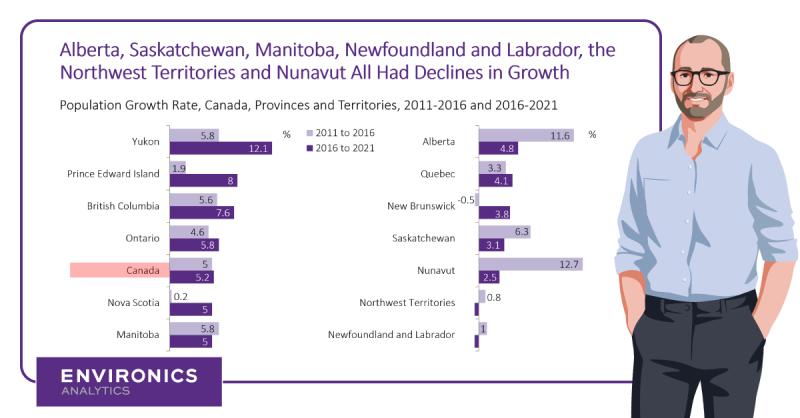This morning, Statistics Canada released the first data from the 2021 Census, covering the total population and dwelling counts for all geographic areas of the country.
The results show that Canada had a population of 36,991,981 in 2021, up 1.8 million from 2016. This represents a growth of 5.2 percent, compared to a 5.7 percent growth rate of the preceding census period (2011-2016). The drop in national growth was a result of very low growth during the pandemic, which accounted for 14 months of the five-year period.
Overall, about eighty percent of Canada’s total growth can be attributed to immigration, and during the pre-pandemic period, 2016-2020 period immigration was particularly high for international students and temporary workers.
The country continues to boast the fastest-growing population amongst G-7 nations much above the United Kingdom (2.9%) and the United States (2.6%).
Increased Growth in the Maritime Provinces
The provincial pattern of growth differed from the previous census period due to increased immigration levels and shifts in interprovincial migration due to the collapse of the resource sector.
In Alberta, Saskatchewan, Manitoba and Newfoundland and Labrador, population growth was down. On the other hand, the three Maritime provinces experienced their highest growth in 40 years due to immigration and gains in interprovincial migration, mainly from Ontario.
Among the provinces, Prince Edward Island registered the highest growth rate (8%), while at the other extreme, Newfoundland and Labrador experienced a small loss of population.
 Pictured above: Population growth rates by province/territory for the latest census period (2016-2021).
Pictured above: Population growth rates by province/territory for the latest census period (2016-2021).
New Census Metropolitan areas in British Columbia were Among Fastest Growing Metropolitan Areas
There were six new census metropolitan areas (100,000 and over) for the most recent census period—Red Deer in Alberta, Kamloops, Nanaimo, and Chilliwack in British Columbia, Fredericton in New Brunswick and Drummondville in Quebec, bringing the total number to 41. The four fastest-growing CMAs were in British Columbia- Kelowna (14%), Chilliwack (12.1%), Nanaimo (10%) and Kamloops (10%) followed by London (10%), Kitchener-Cambridge-Waterloo (9.9%), Oshawa (9.3%), and Halifax (9.1%).
The largest CMAs grew at more moderate rates: Vancouver (7.3 percent), Toronto (4.6%) and Montreal (4.6%). Although these areas continued to attract a high number of immigrants, they actually experienced a net outflow of population to other parts of the province. It is likely much of this outflow stems from retirees moving out to smaller towns and rural settings as well as young families moving further away from the big cities in search of more affordable housing.


